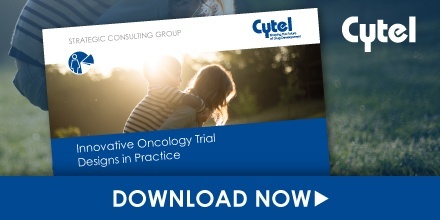Addressing Critical Unmet Oncology Needs in the Era of Precision Medicine


Our Industry Voices series showcases our clients’ innovative work and breakthrough therapeutics in oncologic indications and other critical areas of medical unmet need.
In this article, we sit down with Charles Theuer, M.D., CEO of TRACON Pharmaceuticals to discuss
his work, his views on the key advancements in oncology development, the unmet needs yet to be overcome, and the importance of efficient trial design in rare cancers. Click here to download a .pdf of the article, or read on.

Could you tell us about your role and the work that TRACON Pharmaceuticals does?
I’ve been CEO of TRACON Pharmaceuticals for 11 years. Our focus at TRACON has always been oncology drug development, with the emphasis on developing either first-in-class or best-in-class therapeutics to address unmet needs in cancer care. We prefer not to develop a drug that addresses a mechanism of action that’s already been successfully targeted by an approved therapeutic. For us to be
interested in a drug, it needs to have potential to make a difference by addressing either a new target, or a validated target in a novel way. Those are the themes that were the basis for starting TRACON. As the company has evolved, we’ve also become a unique drug development organization. We developed our “Product Development Platform”, which allows us to execute our own trials and manage clinical and manufacturing regulatory activities using our own team. By doing so, we feel we accelerate timelines and
complete trials at a much lower cost. Our pipeline now includes a Phase 3 asset, TRC105, which we’ve advanced with the help of Cytel into an award-winning pivotal trial design. We also have a Phase 2 asset
that’s moving forward in collaboration with National Cancer Institute. Finally, we have a Phase 1 asset that we’re moving forward in collaboration with Johnson & Johnson. Those assets are all being developed by our team, using our product development platform to accelerate development.
"I view the developing of targeted therapies that enable precision medicine as the biggest change in oncology research over the last ten years."
What are the most striking changes you’ve seen in oncology therapy, and development over the last ten years?
As a general principle, I view the developing of targeted therapies that enable precision medicine as the biggest change in oncology research over the last ten years. Ten years ago, cancer was treated almost entirely through non-specific therapies. Chemotherapy, that non-specifically targets proliferating cells and cancers, was and will remain useful therapy for many patients. However, in the last ten years, what’s really been exciting has been the development of targeted agents. As an example, I was involved at Pfizer with the development of Sutent®, a targeted agent that revolutionized the care of kidney cancer by targeting dysregulated angiogenic pathways that characterize this tumor type. The approval of Sutent represented a huge advance in cancer care for kidney cancer patients compared to the pre-existing standard of care, which was Interferon alpha. As the field has continued to evolve, kinase inhibitors, of which Sutent is an example, have impacted many diseases. But now the landscape has become even more exciting with precision medicines that include,for instance, CAR T therapies that are now approved in certain forms of leukemia. There are also new agents targeting receptors that restrict the immune cells that control cancer growth and metastasis. These checkpoint inhibitors can relieve the immunosuppression within a tumor, and allow the native immune system to attack the tumor. The era of precision medicine allows physicians to identify individual patient characteristics or tumor types that might be most susceptible to a given therapy, and represents a huge advance in cancer care.
Click here to download a pdf copy of the article
What do you see as being the opportunities moving forward, and the barriers that are still to be overcome?
We’ve made great advances in certain tumor types. Unfortunately, there are still many tumor types that remain poorly addressed by current therapies. Cancer is a multi-factorial process, and in most cases, there are multiple pathways that are dysregulated. Some of these pathways are also involved in normal cellular metabolism and normal processes, so it can be difficult to target a specific process in a cancer
cell without having significant side effects. Therefore, while we’ve made incredible advances in certain areas, there are still many cancers where the standard of care is very poor in terms of results for patients.
Angiosarcoma is one focus for us where current therapies produce poor outcomes. For instance, chemotherapy is used, but most patients will progress within four to five months of starting therapy. Votrient, which targets certain angiogenic processes, is also approved for the treatment of angiosarcoma, but also has fairly poor activity, with most patients progressing within three months of starting
therapy.

Could you describe the background of the TAPPAS trial, and how its design has helped to address some of the development challenges that are facing angiosarcoma?
The Phase 3 TAPPAS pivotal trial uses a unique adaptive design that addresses the fact that angiosarcoma is an ultra-orphan indication. To address a rare tumor,you don’t have the opportunity
to do multiple trials in multiple settings that characterize the more typical drug development paradigm in oncology. In a rare tumor type, if you take that approach, the time that it will take to develop a drug will be too long. With the Phase 3 TAPPAS trial, we wanted to design a single study that would allow for the opportunity for global approval in an orphan indication. We felt we could address development in angiosarcoma in a unique way by incorporating an adaptive design and collaborated with Cytel in this regard. The TAPPAS trial compares the efficacy of Votrient as a single agent compared to Votrient plus
our experimental drug TRC105. Comparing the standard of care drug with or without a new drug is very standard. However, we advanced into Phase 3 with estimates of clinical benefit that weren’t based
on randomized phase 2 data. We knew that Votrient as a single agent demonstrated progression-free survival, or PFS, of about three months in patients who had not previously been treated with a VEGF inhibitor in a single arm study. We also knew from our phase 2 single arm study, that TRC105 combined with Votrient demonstrated progression-free survival of about eight months in patients who had not previously been treated with a VEGF inhibitor.
"...we wanted to avoid seeing a clinically meaningful significant survival improvement, say from 4 to 7.0 months, that may not meet statistical significance if we only enrolled 124 patients.."
While we are very encouraged by the PFS demonstrated with the combination of TRC105 and Votrient, our study included a relatively small number of patients since angiosarcoma is an ultra-orphan tumor. In designing a phase 3 study, we adopted the basic assumption that Votrient would cause progression-free survival of approximately four months and that the combination of TRC105 and Votrient would increase that survival to 7.3 months, which were based on data from the Phase 2 single arm trials. However, we did not have access to PFS data from a randomized study where patients were treated in the same way in a single trial. Therefore, there was some potential that the treatment effect could be larger or smaller than anticipated. To take that into account, we incorporated an adaptive design that we implemented using the statistical expertise at Cytel. In the TAPPAS trial, we initially plan to enroll 124 patients, which is designed with more than 80% power to detect a PFS improvement from 4 months, with Votrient as a single agent, to 7.3 months with a combination of Votrient and TRC105. However, we can’t be absolutely sure that the improvement will be from 4 to 7.3 months, and we wanted to avoid seeing a clinically meaningful significant survival improvement, say from 4 to 7.0 months, that may not meet statistical significance if we only enrolled 124 patients. Our solution is an adaptive design where we implement an interim analysis that calculates the conditional power to observe the desired treatment effect. The conditional power will tell the Data Monitoring Committee whether or not the trial is on track to see the desired treatment effect of an improvement in PFS from four to 7.3 months. If the trial is on track to see the desired treatment effect with very high conditional power, we could enter the “favorable zone”, which maintains the sample size of 124 patients. However, if the conditional power tells us that we may be more likely to see a less robust treatment effect, we could enter what we call the “promising zone” whereby the trial enrolls 200 patients, which provides greater power to see a less robust treatment effect than was initially estimated.
"It’s important to know that both the EMA and the FDA reviewed the statistical design, and the Phase 3 TAPPAS trial proceeded following special protocol assessment designation from the FDA."
The other important adaptation accounts for the possibility that we may see more pronounced drug effect in patients with the cutaneous form of angiosarcoma,which represents about 50% of the angiosarcoma population. If the combination of TRC105 and Votrient is only effective in patients with cutaneous disease, our goal would still be to approve the drug in these patients. Therefore, if the combination of TRC105 and Votrient appears to be effective in cutaneous patients, with limited activity in non-cutaneous patients, then following the interim analysis, we could enter the “enrichment zone” and enroll only cutaneous patients going forward. This adaptation provides sufficient patients to demonstrate the desired treatment effect in patients with cutaneous disease. Finally, the trial has an “unfavorable zone” if the conditional power indicates the combination of TRC105 and Votrient is not working as expected, in both the overall and the cutaneous angiosarcoma population. In that case, the Data Monitoring Committee may terminate the trial for futility. We see this adaptation as a very powerful way to use the early data from the Phase 3 TAPPAS clinical trial to fully inform both the final sample size and the final eligible population to provide a robust Phase 3 clinical trial in an ultra-orphan cancer type. It’s important to know that both the EMA and the FDA reviewed the statistical design, and the Phase 3 TAPPAS trial proceeded following special protocol assessment designation from the FDA. It was also nice to see the Phase 3 TAPPAS trial receive a Clinical & Research Excellence, or CARE, award from Pharma Intelligence for the Most Innovative Clinical Trial of 2017.
"The five year survival for angiosarcoma is about 12% - so we absolutely need new therapies."
What value does a statistical collaboration bring to your development planning and decision making?
The statistical planning and consultation with Cytel as part of the Phase 3 TAPPAS trial design was absolutely critical. It brought us great credibility with regulators in Europe and the US. When you talk about statistics, you must talk about statistics in the context of relevant clinical information. The Phase
3 TAPPAS trial is designed to show not only that TRC105 is a beneficial therapy, but also to show that it results in improved survival that is clinically meaningful. Each of the zones in the adaptive design allows us to detect a clinically meaningful benefit that will also be statistically significant. When you design a clinical trial, you’re really trying to provide the best opportunity to demonstrate activity. I think we’ve done that with the Phase 3 TAPPAS trial.
What impact do you hope your work will have?
The five year survival for angiosarcoma is about 12% - so we absolutely need new therapies. Our focus on angiosarcoma reflects the fact that the target of TRC105, the endoglin receptor, is abundantly expressed in angiosarcoma, and we’ve seen encouraging PFS and complete responses when we combine TRC105 with Votrient. We are studying TRC105 in angiosarcoma to exploit the biology of
endoglin, with the hope that we will be able to approve a new drug for a patient population that desperately needs it.
Interested in innovative oncology trial designs? Download a copy of our ebook here.
Charles Theuer, MD, PhD
Dr. Theuer has served as President and Chief Executive Officer of TRACON Pharmaceuticals and as a member of the board of directors since July 2006. From 2004 to 2006, Dr. Theuer was the Chief Medical Officer, and Vice President of Clinical Development at TargeGen, Inc., a biotechnology company, where he led the development of small molecule kinase inhibitors in oncology, ophthalmology and cardiovascular disease. Prior to joining TargeGen, Inc., Dr. Theuer was Director of Clinical Oncology at Pfizer, Inc., a pharmaceutical corporation, from 2003 to 2004. At Pfizer, Dr. Theuer led the clinical development of Sutent® in kidney cancer; Sutent® was approved by the U.S. Food and Drug Administration in 2006 for the treatment of advanced kidney cancer. Dr. Theuer has also held senior positions at IDEC Pharmaceuticals Corp. from 2002 to 2003 and at the National Cancer Institute from 1991 to 1993. In addition, he has held academic positions at the University of California, Irvine, where he was Assistant Professor in the Division of Surgical Oncology and Department of Medicine. Dr. Theuer received a B.S. from the Massachusetts Institute of Technology, an M.D. from the University of California, San
Francisco, and a Ph.D. from the University of California, Irvine. He completed a general surgery residency
program at Harbor-UCLA Medical Center and was board certified in general surgery in 1997. Dr. Theuer’s previous research involved immunotoxin and cancer vaccine development, translational work in cancer patients, and gastrointestinal cancer epidemiology.
About TRACON
TRACON develops targeted therapies for cancer and ophthalmic diseases. The Company’s clinical-stage
pipeline includes: TRC105, an endoglin antibody that is being developed for the treatment of multiple cancers; DE-122, the ophthalmic formulation of TRC105 that is being developed in wet AMD through a collaboration with Santen Pharmaceutical Company Ltd.; TRC102, a small molecule being developed for the treatment of lung cancer and glioblastoma; and TRC253, a small molecule being developed for the treatment of prostate cancer. To learn more about TRACON and its product candidates, visit TRACON’s website at www.traconpharma.com.


